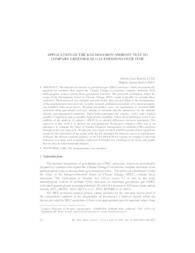Application of the Kolmogorov-Smirnov test to compare greenhouse gas emissions over time.
Application of the Kolmogorov-Smirnov test to compare greenhouse gas emissions over time.
Autoria: LUIZ, A. J. B.; LIMA, M. A. de
Resumo: Abstract: The national inventories of greenhouse gas (GHG) emissions, which are periodically prepared by countries that signed the Climate Change Convention, compute emissions from anthropogenic sources among them agricultural activities. The protocols established within the scope of the International Panel on Climate Change (IPCC) make it possible to estimate these emissions. These protocols use standard emission factors that vary according to the characteristics of the monitored activities and only scientific research, published in journals of recognized quality, can establish other local factors. Brazilian researchers carry out experiments to measure GHG emissions from agricultural activities, aiming to calculate specific parameters for the national climatic and management conditions. These field experiments are complex, costly, with a limited number of repetitions and, eventually, high natural variability. Often, these limitations result in the inability of the analysis of variance (ANOVA) to identify differences between treatments. The objective of this work is to present the non-parametric Kolmogorov-Smirnov (KS) test as an alternative to compare the effect of flooded irrigation management on methane (CH4) emission throughout the rice crop cycle. We present a case study in which ANOVA produced non-significant results for the adjustment of the model while the KS identified the emission curves as significantly different. The KS test could be adapted, via the SAS NPAR1WAY routine, to compare events with responses over time, such as methane emissions in flooded rice, resulting in test values and graphs that are easy to understand and interpret.
Ano de publicação: 2021
Tipo de publicação: Artigo de periódico
Unidade: Embrapa Meio Ambiente
Palavras-chave: Efeito Estufa, GHG, Greenhouse gas emissions, KS, Metano, Methane, Método Estatístico, Nonparametric tests, Statistical analysis
Observações
1 - Por padrão são exibidas publicações dos últimos 20 anos. Para encontrar publicações mais antigas, configure o filtro ano de publicação, colocando o ano a partir do qual você deseja encontrar publicações. O filtro está na coluna da esquerda na busca acima.
2 - Para ler algumas publicações da Embrapa (apenas as que estão em formato ePub), é necessário ter, no celular ou computador, um desses softwares gratuitos. Sistemas Android: Google Play Livros; IOS: iBooks; Windows e Linux: software Calibre.
Acesse outras publicações
Acesse a Base de Dados da Pesquisa Agropecuária (BDPA) para consultar o acervo completo das bibliotecas da Embrapa.

